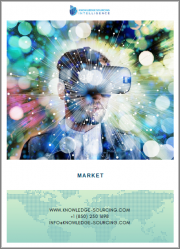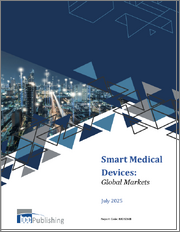
|
시장보고서
상품코드
1410189
세계의 스마트 의료기기 시장 : 예측(2023-2028년)Smart Medical Device Market - Forecasts from 2023 to 2028 |
||||||
세계의 스마트 의료기기(Smart Medical Device) 시장은 2021년 1,363억 9,500만 달러에서 2028년 2,713억 4,300만 달러로 10.33%의 CAGR로 추이하며 성장 할 것으로 예상됩니다.
무선 및 스마트폰 호환 의료 기기에 대한 수요 증가, 기기 기술 혁신, 피트니스에 대한 소비자 인식 증가로 인해 글로벌 스마트 의료 기기 시장이 성장하고 있습니다. 또한 이러한 기기는 사용이 간편하고 결과를 이해하는 데 많은 전문 지식이 필요하지 않기 때문에 센서, 심전도 장치, 피트니스 트래커가 있는 스마트워치와 같은 웨어러블 의료 기기에 대한 수요가 증가하고 있습니다. 그 결과, 사용자는 병원이나 클리닉을 자주 방문하지 않고도 생체 신호를 모니터링하여 자신의 건강 상태를 파악할 수 있게 되었습니다. 또한 노인 인구가 스마트 의료 기기의 이러한 측면을 더 쉽게 채택할 것으로 예상됩니다.
또한 유엔이 2022년 7월 발표한 'World Population Prospectus 2022'에서 업데이트된 데이터에 따르면 2022년에는 유럽 및 북미 인구가 가장 고령화되어 인구의 약 19%가 65세 이상 합니다.
만성 질환 증가
당뇨병, 심혈관 질환, 호흡기 질환을 비롯한 만성 질환의 유병률 증가는 전 세계 스마트 의료기기 시장에 큰 영향을 미치고 있습니다. 예를 들어, IDF 당뇨병 아틀라스(2021)에 따르면 성인(20-79세)의 10.5%가 당뇨병을 앓고 있으며, 같은 자료에 따르면 2045년에는 성인 8명 중 1명꼴인 약 7억 8,300만 명이 당뇨병을 앓게 되어 46% 증가할 것으로 예상됩니다. 의료 부문은 만성 질환을 치료하고, 고령 인구의 효율적인 노후를 지원하며, 병원 입원 치료에서 외래 재택 치료로 원활하게 전환할 수 있도록 보장하는 데 큰 관심을 갖고 있습니다. 스마트 의료 기기는 치료 계획을 제대로 따르고 건강 지표를 인식함으로써 모니터링 및 관리 솔루션을 지원합니다.
인도의 스마트 의료기기 시장은 꾸준히 성장할 것으로 예측
인도는 최근 몇 년 동안 스마트 의료기기 산업이 크게 성장하고 있으며, 이는 전체 헬스케어 산업에서 중요한 부문이 되었습니다. 의료비 지출 증가와 의료 분야에서 기술 사용을 촉진하기 위한 인도 정부의 이니셔티브와 같은 요인으로 인해 스마트 의료 기기에 대한 수요가 증가하고 있으며, 이는 다시 접근성과 효율성을 높이는 전문 의료 기술에 대한 필요성을 불러일으키고 있습니다. 2022-23년 경제 조사에 따르면, 인도의 의료 분야에 대한 공공 지출은 21년 1.6%에서 23년 2.1%, 22년 2.2%를 기록했습니다.
증가하는 인도 정부의 이니셔티브
인도 정부의 이니셔티브는 인도 스마트 의료기기 시장의 성장과 발전에도 중요한 역할을 하고 있습니다. '메이크 인 인디아' 이니셔티브는 인도의 제조 역량을 강화했을 뿐만 아니라 국내에서 개발된 강력한 디지털 인프라를 위한 기반을 마련하여 국민에게 큰 혜택을 주고 있습니다. 인도 전역에 향상된 의료 서비스를 제공하는 생태계를 구축하기 위해 나렌드라 모디 총리는 2020년 인도 제84회 독립기념일에 국가 디지털 건강 미션(NDHM)을 발표했습니다.
디지털 수단을 통해 개인을 효율적으로 식별 및 연결하고 일상생활을 간소화하는 기존의 디지털 인프라에는 Aadhaar 고유 신원(UID), JAM 삼위일체(얀 단-아다하르-모바일), 통합 결제 인터페이스(UPI) 등 핵심 구성 요소가 포함되어 있습니다. 이러한 강력한 디지털 기반은 디지털 관리를 통해 의료 서비스를 더욱 발전시키고 향상시킬 수 있는 NDHM의 견고한 발판을 제공합니다.
시장의 주요 발전
- 2022년 11월, Medtronic은 미국에서 'Medtronic Extended Fusion Set'를 출시했습니다.
목차
제1장 서론
- 시장 개요
- 시장 정의
- 조사 범위
- 시장 세분화
- 통화
- 전제 조건
- 기준연도 및 예측연도의 타임라인
제2장 조사 방법
- 조사 데이터
- 전제 조건
제3장 주요 요약
- 조사 하이라이트
제4장 시장 역학
- 시장 성장 촉진 요인
- 시장 성장 억제 요인
- Porter's Five Forces 분석
- 산업 밸류체인 분석
제5장 세계의 스마트 의료기기 시장 : 유형별
- 소개
- 진단 및 감시 장치
- 치료기기
제6장 세계의 스마트 의료기기 시장 : 용도별
- 소개
- 심장혈관
- 신경내과
- 호흡기계
- 기타
제7장 세계 스마트 의료기기 시장 : 최종 사용자별
- 소개
- 병원 및 진료소
- 외래 진료 센터
- 가정치료 환경
제8장 세계 스마트 의료기기 시장 : 지역별
- 소개
- 북미
- 유형별
- 용도별
- 최종 사용자별
- 국가별
- 남미
- 유형별
- 용도별
- 최종 사용자별
- 국가별
- 유럽
- 유형별
- 용도별
- 최종 사용자별
- 국가별
- 중동 및 아프리카
- 유형별
- 용도별
- 최종 사용자별
- 국가별
- 아시아 태평양
- 유형별
- 용도별
- 최종 사용자별
- 국가별
제9장 경쟁 환경 및 분석
- 주요 기업 및 전략 분석
- 시장 점유율 분석
- 합병, 인수, 계약 및 협력
- 벤더 경쟁력 지수
제10장 기업 개요
- Boston Scientific Corporation
- ViVO Smart Medical Devices Ltd
- Dexcom Inc
- Abbott Laboratories
- Medtronic Plc.
- NeuroMetrix, Inc.
- Omron Healthcare, Inc.
The global smart medical devices market is estimated to grow at a CAGR of 10.33% reaching US$271.343 billion in 2028 from US$136.395 billion in 2021.
The global smart medical devices market growth is being propelled by the increasing demand for wireless and smartphone-compatible medical equipment, device technology breakthroughs, and increased consumer awareness of fitness. Moreover, as these devices are simple to use and don't require a lot of specialized knowledge to understand the results, demand for wearable medical devices has increased like sensors, ECG devices, and smartwatches with fitness trackers. As a result, the user can monitor their vital signs to maintain tabs on their health status without having to often visit clinics or hospitals. Additionally, the elderly population is anticipated to adopt this aspect of smart medical devices more readily.
Furthermore, according to data updated by the UN in its World Population Prospectus 2022, which was published in July 2022, Europe and Northern America had the oldest populations in 2022, with nearly 19% of the population being 65 years of age or older.
Rising prevalence of chronic diseases
The rise in the prevalence of chronic diseases including diabetes, cardiovascular, and respiratory problems has a big impact on the global smart medical devices market. For instance, 10.5% of adults (20-79 years) have diabetes, according to the IDF Diabetes Atlas (2021), and as per the same source nearly 783 million adults, or one in eight, would have diabetes by 2045, a 46% rise. The healthcare sector is highly concerned with treating chronic illnesses, offering efficient aging-in-place support to an older population, and guaranteeing a seamless transition from inpatient hospital care to outpatient home care. By properly following the treatment plans and recognizing health metrics, smart medical devices assist in monitoring and managing solutions.
It is projected that the smart medical devices market in India will grow steadily.
India has been experiencing significant growth in the smart medical devices industry in recent years, making it a significant segment within the broader healthcare industry. Factors such as increasing healthcare expenditure followed by the Indian governmental initiatives to promote the use of technology in healthcare are driving the demand for smart medical devices, which in turn drives the need for specialized medical technologies making them more accessible and efficient. According to the Economic Survey 2022-23, India's public expenditure on healthcare touched 2.1 % of GDP in FY23 and 2.2% in FY22, against 1.6% in FY21.
Increasing Government Initiatives in India
Indian government initiatives are also playing a significant role in the growth and development of the smart medical devices market in the country. The Make in India initiative has not only bolstered the country's manufacturing capabilities but has also paved the way for a robust and domestically developed digital infrastructure, greatly benefiting the citizens. In a bid to establish an ecosystem that delivers improved healthcare services across India, Prime Minister Narendra Modi announced the National Digital Health Mission (NDHM) on India's 84th Independence Day in 2020.
This existing digital infrastructure, which efficiently identifies and connects individuals and simplifies their daily lives through digital means, includes key components like the Aadhaar Unique Identity (UID), the JAM trinity (Jan Dhan-Aadhaar-Mobile), and the Unified Payments Interface (UPI). This strong digital foundation provides a solid launching pad for NDHM, facilitating further development and enhancement of healthcare services through digital management.
Market Key Developments
- In November 2022, Medtronic launched the "Medtronic Extended Fusion Set" in the US which uses advanced materials for reducing insulin preservative loss and thereby maintaining insulin flow.
Segmentation:
By Type
- Diagnostic and Monitoring Devices
- Therapeutic Devices
By Application
- Cardiovascular
- Neurology
- Respiratory
- Others
By End-User
- Hospitals and Clinics
- Ambulatory Care Centers
- Home Care Settings
By Geography
- North America
- United States
- Canada
- Mexico
- South America
- Brazil
- Argentina
- Others
- Europe
- United Kingdom
- Germany
- France
- Spain
- Others
- Middle East and Africa
- Saudi Arabia
- Israel
- Others
- Asia Pacific
- Japan
- China
- India
- South Korea
- Others
TABLE OF CONTENTS
1. INTRODUCTION
- 1.1. Market Overview
- 1.2. Market Definition
- 1.3. Scope of the Study
- 1.4. Market Segmentation
- 1.5. Currency
- 1.6. Assumptions
- 1.7. Base, and Forecast Years Timeline
2. RESEARCH METHODOLOGY
- 2.1. Research Data
- 2.2. Assumptions
3. EXECUTIVE SUMMARY
- 3.1. Research Highlights
4. MARKET DYNAMICS
- 4.1. Market Drivers
- 4.2. Market Restraints
- 4.3. Porter's Five Force Analysis
- 4.3.1. Bargaining Power of Suppliers
- 4.3.2. Bargaining Power of Buyers
- 4.3.3. Threat of New Entrants
- 4.3.4. Threat of Substitutes
- 4.3.5. Competitive Rivalry in the Industry
- 4.4. Industry Value Chain Analysis
5. GLOBAL SMART MEDICAL DEVICES MARKET, BY TYPE
- 5.1. Introduction
- 5.2. Diagnostic and Monitoring Devices
- 5.3. Therapeutic Devices
6. GLOBAL SMART MEDICAL DEVICES MARKET, BY APPLICATION
- 6.1. Introduction
- 6.2. Cardiovascular
- 6.3. Neurology
- 6.4. Respiratory
- 6.5. Others
7. GLOBAL SMART MEDICAL DEVICES MARKET, BY END-USER
- 7.1. Introduction
- 7.2. Hospitals and Clinics
- 7.3. Ambulatory Care Centers
- 7.4. Home Care Settings
8. GLOBAL SMART MEDICAL DEVICES MARKET, BY GEOGRAPHY
- 8.1. Introduction
- 8.2. North America
- 8.2.1. By Type
- 8.2.2. By Application
- 8.2.3. By End-User
- 8.2.4. By Country
- 8.2.4.1. USA
- 8.2.4.2. Canada
- 8.2.4.3. Mexico
- 8.3. South America
- 8.3.1. By Type
- 8.3.2. By Application
- 8.3.3. By End-User
- 8.3.4. By Country
- 8.3.4.1. Brazil
- 8.3.4.2. Argentina
- 8.3.4.3. Others
- 8.4. Europe
- 8.4.1. By Type
- 8.4.2. By Application
- 8.4.3. By End-User
- 8.4.4. By Country
- 8.4.4.1. UK
- 8.4.4.2. Germany
- 8.4.4.3. France
- 8.4.4.4. Spain
- 8.4.4.5. Others
- 8.5. Middle East and Africa
- 8.5.1. By Type
- 8.5.2. By Application
- 8.5.3. By End-User
- 8.5.4. By Country
- 8.5.4.1. Saudi Arabia
- 8.5.4.2. Israel
- 8.5.4.3. Others
- 8.6. Asia Pacific
- 8.6.1. By Type
- 8.6.2. By Application
- 8.6.3. By End-User
- 8.6.4. By Country
- 8.6.4.1. Japan
- 8.6.4.2. China
- 8.6.4.3. India
- 8.6.4.4. South Korea
- 8.6.4.5. Others
9. COMPETITIVE ENVIRONMENT AND ANALYSIS
- 9.1. Major Players and Strategy Analysis
- 9.2. Market Share Analysis
- 9.3. Mergers, Acquisition, Agreements and Collaboration
- 9.4. Vendor Competitiveness Index
10. COMPANY PROFILES
- 10.1. Boston Scientific Corporation
- 10.2. ViVO Smart Medical Devices Ltd
- 10.3. Dexcom Inc
- 10.4. Abbott Laboratories
- 10.5. Medtronic Plc.
- 10.6. NeuroMetrix, Inc.
- 10.7. Omron Healthcare, Inc.

















